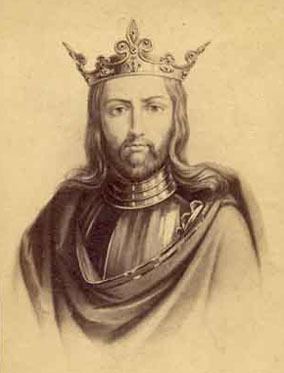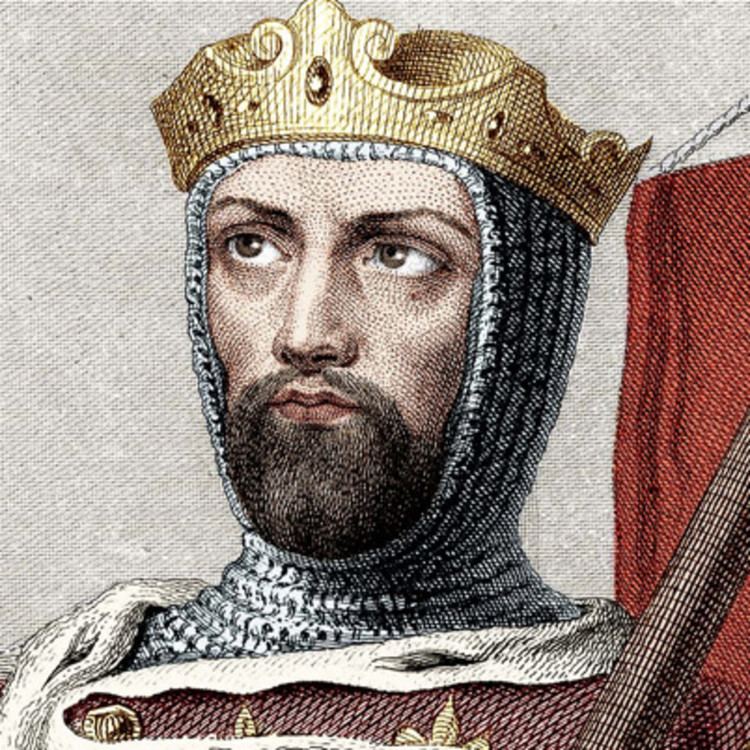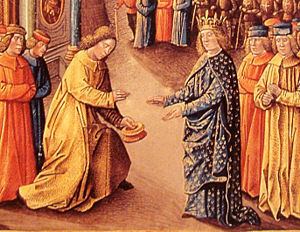Role King Name Louis of | Burial Saint Denis Basilica Children Philip II of France | |
 | ||
Junior kingSenior king 25 October 1131 – 1 August 11371 August 1137 – 18 September 1180 Issue Marie, Countess of ChampagneAlix, Countess of BloisMargaret, Queen of HungaryAlys, Countess of the VexinPhilip II of FranceAgnes, Byzantine Empress Died September 18, 1180, Saint-Pont, France Spouse Siblings Constance of France, Countess of Toulouse Parents Adelaide of Maurienne, Louis VI of France Similar People Eleanor of Aquitaine, Louis VI of France, Philip II of France, Henry II of England, Louis VIII of France | ||
Louis vii of france
Louis VII (called the Younger or the Young) (French: Louis le Jeune) (1120 – 18 September 1180) was King of the Franks from 1137 until his death. He was the son and successor of King Louis VI of France, hence his nickname ("the young/er"). Louis VII's reign saw the disastrous Second Crusade, as also the founding of the University of Paris. Louis and his famous counselor, Abbot Suger, pushed for a greater centralization of the state and favoured the development of French Gothic architecture, notably the construction of Notre-Dame de Paris.
Contents
- Louis vii of france
- Louis VII of France Wikipedia audio article
- Early years
- Early reign
- A shift in the status quo
- Diplomacy
- Marriages and children
- Legacy
- Fictional portrayals
- References

In 1137, Louis married the notorious Eleanor of Aquitaine, the largest heiress in western Europe at that time, who brought the vast duchy of Aquitaine as her dowry. The marriage was unhappy due to Eleanor's defects of character and personality. After fifteen years of marriage and two daughters, the marriage was annulled on the pretext of consanguinity in 1152, and Louis thus lost Aquitaine. Less than two months later, Eleanor married the future Henry II of England. Two years later, Louis married Constance of Castile, who also bore him two daughters before dying on childbed. He then married Adela of Champagne, who finally bore him the much-awaited son and heir in 1165. Louis died in 1180 and was succeeded by his son Philip II.

Louis VII of France | Wikipedia audio article
Early years

Louis was born in 1120 in Paris, the second son of Louis VI of France and Adelaide of Maurienne. The early education of Prince Louis anticipated an ecclesiastical career. As a result, he became well-learned and exceptionally devout, but his life course changed decisively after the accidental death of his older brother Philip in 1131, when he unexpectedly became the heir to the throne of France. In October 1131, his father had him anointed and crowned by Pope Innocent II in Reims Cathedral. He spent much of his youth in Saint-Denis, where he built a friendship with the Abbot Suger, an advisor to his father who also served Louis well during his early years as king.
Early reign

Following the death of William X, Duke of Aquitaine, Louis VI moved quickly to have Prince Louis married to Eleanor, Duchess of Aquitaine, heiress of the late duke, on 25 July 1137. In this way, Louis VI sought to add the large, sprawling territory of the Aquitaine to his family's holdings in France. On 1 August 1137, shortly after the marriage, Louis VI died, and Prince Louis became king of France, reigning as Louis VII. The pairing of the monkish Louis and the high-spirited Eleanor was doomed to failure; she reportedly once declared that she had thought to marry a king, only to find she had married a monk. There was a marked difference between the frosty, reserved culture of the northern court in the Íle de France, where Louis had been raised, and the rich, free-wheeling court life of the Aquitaine with which Eleanor was familiar. Louis and Eleanor had two daughters, Marie and Alix.

In the first part of his reign, Louis VII was vigorous and zealous in his prerogatives. His accession was marked by no disturbances other than uprisings by the burgesses of Orléans and Poitiers, who wished to organise communes. He soon came into violent conflict with Pope Innocent II, however, when the archbishopric of Bourges became vacant. The king supported the chancellor Cadurc as a candidate to fill the vacancy against the pope's nominee Pierre de la Chatre, swearing upon relics that so long as he lived, Pierre should never enter Bourges. The pope thus imposed an interdict upon the king.
Louis VII then became involved in a war with Theobald II of Champagne by permitting Raoul I of Vermandois, the seneschal of France, to repudiate his wife, Theobald II's niece, and to marry Petronilla of Aquitaine, sister of the queen of France. As a result, Champagne decided to side with the pope in the dispute over Bourges. The war lasted two years (1142–1144) and ended with the occupation of Champagne by the royal army. Louis VII was personally involved in the assault and burning of the town of Vitry-le-François. More than a thousand people who had sought refuge in the church died in the flames. Overcome with guilt and humiliated by ecclesiastical reproach, Louis admitted defeat, removed his armies from Champagne and returned them to Theobald. He accepted Pierre de la Chatre as archbishop of Bourges and shunned Raoul and Petronilla. Desiring to atone for his sins, he declared his intention of mounting a crusade on Christmas Day 1145 at Bourges. Bernard of Clairvaux assured its popularity by his preaching at Vezelay on Easter 1146.
In the meantime, Geoffrey V, Count of Anjou, completed his conquest of Normandy in 1144. In exchange for being recognised as Duke of Normandy by Louis, Geoffrey surrendered half of the Vexin — a region vital to Norman security — to Louis. Considered a clever move by Louis at the time, it would later prove yet another step towards Angevin rule.
In June 1147, in fulfilment of his vow to mount the Second Crusade, Louis VII and his queen set out from the Basilica of St Denis, first stopping in Metz on the overland route to Syria. Soon they arrived in the Kingdom of Hungary, where they were welcomed by the king Géza II of Hungary, who was already waiting with King Conrad III of Germany. Due to his good relationships with Louis VII, Géza II asked the French king to be his son Stephen's baptism godfather. Good relationships between the kingdoms of France and Hungary continued to remain cordial long after this time: decades later, Louis's daughter Margaret was taken as wife by Géza's son Béla III of Hungary. After receiving provisions from Géza, the armies continued the march to the East. Just beyond Laodicea, the French army was ambushed by Turks. The French were bombarded by arrows and heavy stones, and the Turks swarmed down from the mountains. Then a massacre began. The historian Odo of Deuil reported:
During the fighting the King Louis lost his small and famous royal guard, but he remained in good heart and nimbly and courageously scaled the side of the mountain by gripping the tree roots … The enemy climbed after him, hoping to capture him, and the enemy in the distance continued to fire arrows at him. But God willed that his cuirass should protect him from the arrows, and to prevent himself from being captured he defended the crag with his bloody sword, cutting off many heads and hands.
Louis VII and his army finally reached the Holy Land in 1148. His queen Eleanor supported her uncle, Raymond of Antioch, and prevailed upon Louis to help Antioch against Aleppo. But Louis VII's interest lay in Jerusalem, and so he slipped out of Antioch in secret. He united with King Conrad III of Germany and King Baldwin III of Jerusalem to lay siege to Damascus; this ended in disaster and the project was abandoned. Louis VII decided to leave the Holy Land, despite the protests of Eleanor, who still wanted to help her doomed uncle Raymond. Louis VII and the French army returned home in 1149.
A shift in the status quo
The expedition to the Holy Land came at a great cost to the royal treasury and military. It also precipitated a conflict with Eleanor that lead to the annulment of their marriage. Perhaps the marriage to Eleanor might have continued if the royal couple had produced a male heir, but this had not occurred. The Council of Beaugency declared that Louis VII and Eleanor were too closely related for their marriage to be legal, thus the marriage was annulled on 21 March 1152. The pretext of kinship was the basis for annulment, but in fact, it owed more to the state of hostility between Louis and Eleanor, the decreasing likelihood that their marriage would produce a male heir to the throne of France. On 18 May 1152, Eleanor married the Count of Anjou, the future King Henry II of England. She gave him the duchy of Aquitaine and bore him three daughters and five sons. Louis VII led an ineffective war against Henry for having married without the authorization of his suzerain. The result was a humiliation for the enemies of Henry and Eleanor, who saw their troops routed, their lands ravaged, and their property stolen. Louis reacted by coming down with a fever and returned to the Ile-de France.
In 1154, Louis VII married Constance of Castile, daughter of Alfonso VII of Castile. She also failed to supply him with a son and heir, bearing only two daughters, Marguerite and Alys. By 1157, Henry II of England began to believe that Louis might never produce a male heir, and that the succession of France would consequently be left in question. Determined to secure a claim for his family, he sent the Chancellor, Thomas Becket, to press for a marriage between Princess Marguerite and Henry's heir, also called Henry (later Henry the Young King). Louis, surprisingly, agreed to this proposal, and by the Treaty of Gisors (1158), betrothed the young pair, giving as a dowry the Norman Vexin and Gisors.
Constance died in childbirth on 4 October 1160, and five weeks later, Louis VII married Adèle of Champagne. To counterbalance the advantage this would give the king of France, Henry II had the marriage of their children (Henry "the Young King" and Marguerite) celebrated at once. Louis understood the danger of the growing Angevin power; however, through indecision and a lack of fiscal and military resources in comparison to Henry II, he failed to oppose Angevin hegemony effectively. One of his few successes was a trip to Toulouse in 1159 to aid Raymond V, Count of Toulouse, who had been attacked by Henry II: after he entered into the city with a small escort, claiming to be visiting his sister, the Countess, Henry declared that he could not attack the city while his liege lord was inside, and went home.
Diplomacy
At the same time, Emperor Frederick I of Germany in the east was making good the imperial claims on Arles in the east. When a papal schism broke out in 1159, Louis VII took the part of Pope Alexander III, the enemy of Frederick I, and after two comical failures of Frederick I to meet Louis VII at Saint Jean de Losne (on 29 August and 22 September 1162), Louis VII definitely gave himself up to the cause of Alexander III, who lived at Sens from 1163 to 1165. In return for his loyal support, Alexander III gave Louis the golden rose.
More importantly for French—and English—history would be Louis's support for Thomas Becket, Archbishop of Canterbury, whom he tried to reconcile with Henry II. Louis sided with Becket as much to damage Henry as out of piousness – yet even he grew irritated with the stubbornness of the archbishop, asking when Becket refused Henry's conciliations, "Do you wish to be more than a Saint?"
Louis also supported Henry's rebellious sons, and encouraged Plantagenet disunity by making Henry's sons, rather than Henry himself, the feudal overlords of the Angevin territories in France. But the rivalry among Henry's sons and Louis's own indecisiveness broke up the coalition (1173–1174) between them. Finally, in 1177, the pope intervened to bring the two kings to terms at Vitry-le-François.
In 1165, Louis' third wife bore him a son and heir, Philip II Augustus. Louis had him crowned at Reims in 1179, in the Capetian tradition (Philip would in fact be the last king so crowned). Already stricken with paralysis, Louis himself could not be present at the ceremony. He died on 18 September 1180 in Paris and was buried the next day at Barbeau Abbey, which he had founded. His remains were moved to the Basilica of Saint-Denis in 1817.
Marriages and children
In 1137, Louis married 15-year-old Eleanor of Aquitaine, the largest heiress in western Europe at that time. Eleanor had inherited the vast Duchy of Aquitaine three years previously; she and Louis were enthroned as Duke and Duchess of Aquitained immediately after their wedding. This temporarily extending Louis' lands all the way to the Pyrenees. The couple remained married for fifteen years, and became the parents of two daughters; however, the marriage was unhappy because Eleanor was scandalously immodest and even wanton; she was forward and over-familiar with courtiers, reacted badly to remonstrance, and interfered excessively in matters of state connected to her husband's realm. Also, she bore Louis no sons, which meant that her daughter would inherit Aquitaine but not Capetian France, where the Salic law prevailed; the two realms would once again get separated anyway. The unhappy marriage, which may have survived for reasons of state if there had been a son, was annulled in 1152 on the pretext of consanguinity, and Louis thus lost Aquitaine. Less than two months after the annulment, Eleanor married the future Henry II of England.
Two years after the annulment of his first marriage, Louis married Constance of Castile, She also bore him two daughters before dying on childbed. Interestingly, one of these daughters was married to Henry, a son of Eleanor by her second husband, while the other daughter was betrothed (but not married) to Richard, another son of Eleanor. After the death of his second wife in 1160, Louis married Adela of Champagne, who finally bore him the much-awaited son and heir in 1165. Louis died in 1180 and was succeeded by his son Philip II.
Louis' children by his three marriages:
with Eleanor of Aquitaine:
with Constance of Castile:
with Adele of Champagne:
Legacy
From the point of view of the preservation and expansion of the French royal domains, the reign of Louis VII was a difficult and unfortunate one. Yet royal authority was more strongly felt in the parts of France distant from these domains: more direct and more frequent connections were made with distant vassals, a result largely due to an alliance between the clergy with the crown. Louis VII thus reaped the reward for services rendered the church during the least successful portions of his reign. His greater accomplishments lie in the development of agriculture, population, commerce, the building of stone fortresses, as well as an intellectual renaissance. Considering the significant disparity of political leverage and financial resources between Louis VII and his Angevin rival Henry II, not to mention Henry's superior military skills, Louis VII should be credited with helping to preserve the Capetian dynasty.
Fictional portrayals
Louis is a character in Jean Anouilh's play Becket. In the 1964 film adaptation he was portrayed by John Gielgud, who was nominated for the Academy Award for Best Supporting Actor. He was also portrayed by Charles Kay in the 1978 BBC TV drama series The Devil's Crown. He has a role in Sharon Kay Penman's novels When Christ and His Saints Slept and Devil's Brood. The early part of Norah Lofts' biography of Eleanor of Aquitaine deals considerably with Louis VII, seen through Eleanor's eyes and giving her side in their problematic relationship. Louis is one of the main characters in Elizabeth Chadwick's latest novel The Summer Queen.
